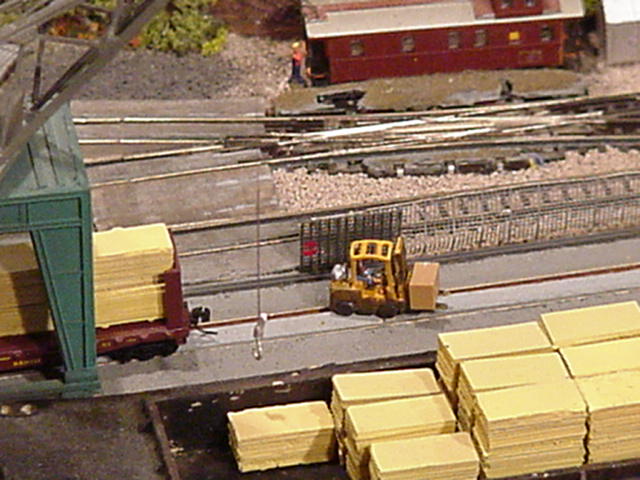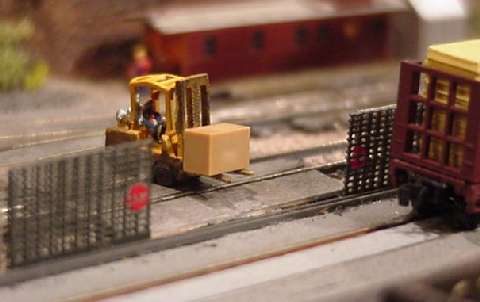The Val Ease Central Railroad ©
Taking Z Scale to the Public Around the World
(Text and photos © Copyright Jeffrey MacHan)
Last Spike: The Forklift Incident / Level Crossing Rerailers
Reporting officer: Constable Duncan Beigne
Date: October 31, 1954
Goods valued over 500$ damaged by forklift operator while on VEPA property.
At approximately 6pm of October 30th last, a witness (Yardmaster Curly Whiskers) observed an unidentified male driving the VEPA forklift at a reckless speed over the level crossing and through the gates of the VEPA quai. The driver then made an attempt to cross the dock rail lead at a 45 degree angle which rocked the forklift resulting in the loss of the load. The driver of the forklift was seen running from the scene and has not been apprehended at this time.
The forklift was undamaged in this incident however the load was completely destroyed when it rolled from the forks, breaking open on the dock apron. According to the shipping manifest, the contents were six 15" color television sets valued at $500 a piece. Witnesses on the dock declared unanimously that it was impossible to recover the contents since they rolled off the apron and into the river.
The investigation is ongoing.

The Forklift involved in the "incident".
At train shows, it is amazing how many times visitors to the VECRR ask how I get the tiny trains on the track. It is understandable how people unfamiliar with "Z" may wonder how the little gems stay on the rails considering how small our rolling stock looks compared to the "giant" HO, O and G scale trains nearby. At least one can actually see the rails on the bigger trains, they say!
What is really surprising is the number of active Z scale modelers who ask the same question. It appears that many of our Z colleagues have not yet discovered the simple technique of installing or converting level crossings to serve as rerailers. Level crossings act to disguise the utilitarian goal of helping us big-fingered types put the trains on the track and to keep them there.
Of course, first one must have level crossings on the layout. These are the roadways and trails that traverse the railroad trackage. They can be highways that are protected by flashing crossbucks and barriers, simple roadways with a level-crossing sign on both sides of the track to warn motorists and pedestrians of the potential danger, or a path used by livestock to move from one pasture to another across the railway. So, the key to railing and rerailing our rolling stock is to have some form of level crossings suitably placed within easy reach around the layout.
Making the rerailer is a matter of choosing a flat piece of styrene or thin wood strip (long thin wood coffee stir sticks are wonderful for this) and cutting them to fit the length of the crossing. Make sure that the height of the material does not pass beyond the level of the rail head otherwise coupler trip pins may run afoul of the crossing and cause derailments instead of preventing them. The width of the strip should be just wide enough to fit nicely centered between the plastic track spike heads molded onto the sleepers (ties).
When selecting the longer strips of wood, pick sections that are straight and do not have any twists or bows. Team tracks and dock loading leads are good candidates for long lengths of rail head level rerailers as vehicles would normally have to cross the tracks the entire length of the leads. Make sure that there is also material covering the ties on the outside of the rails otherwise your delivery trucks would have a hard time getting up and over the crossing.
The styrene or wood strip can be easily glued in place with a thin bead of acrylic based glue, CA or even rubber cement. Be careful to avoid putting too much cement on the area to be glued and immediately wipe off any excess from the rail heads and inside edges if you happen to find it has migrated there. It may be helpful to place a weight on the level crossing to keep the strips nice and flat while the glue cures.
Once the glue has set you'll be pleasantly surprised how easily rolling stock slips onto the rails with a little rocking and side-to-side jiggling over the rerailer. If you find that the rerailer needs adjusting to allow the wheels to roll through unhindered, try timming with a hobby knife. All that is left to do is to apply paint or stain, rub in some black chalk or apply india ink diluted with rubbing alcohol to simulate wear-and-tear and clean the rails one last time to remove any glue, paint, stain or debris from the construction.
Using level crossing rerailers, it becomes easy to put cars back on the track at arm's length and wow the crowds to no end! Next time someone asks what superhuman powers are needed to rerail the rolling stock, you can either admit to having "bionic" fingertips or you can reveal our secret and point to the crossing.
Not only do the rerailers make short work of putting cars on the track, they do help (although not as much as you would think) rerail cars travelling around the layout. And don't forget, level crossings are a normal feature of railroading geography. They add texture and interest to a layout. As rerailers, they make our hobby just a little bit more FUN!

The Forklift is a Gold Medal Models N kit that has undergone some improvementZ".
Enjoy your trainZ.